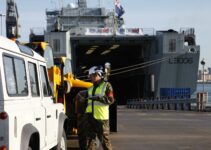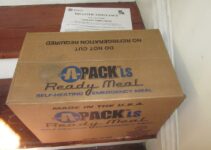Are you prepared for a natural disaster? Emergency situations can happen at any time, and having a nutritious emergency food supply is essential for survival. In this ultimate guide, we'll provide tips for preparing and storing the best foods to keep you healthy and energized during any disaster scenario.
As a nutritionist with years of experience in the field, I know firsthand the importance of a nutritious emergency food supply. In this article, I'll provide you with the information you need to be prepared for any emergency situation.
Understanding Nutritious Emergency Food Supply
| Macronutrients | Examples |
|---|---|
| Carbohydrates | Rice, pasta, crackers, oats, cereals |
| Proteins | Canned beans, meats, jerky, nuts, seeds |
| Fats | Peanut butter, nuts, oil, canned fish |
| Micronutrients | Examples |
|---|---|
| Vitamins | Canned fruits and vegetables, dried fruits, energy bars |
| Minerals | Canned beans, nuts, seeds, dried fruits |
When preparing an emergency food supply, it's crucial to have a balance of macronutrients and micronutrients. The table above provides examples of different types of macronutrients and micronutrients to include in your emergency food supply. It's essential to choose a variety of foods to ensure that you get all the necessary nutrients for your body to function correctly.
A nutritious emergency food supply refers to food that can provide the necessary nutrients required by the human body, can be stored for long periods, and is easy to prepare. In disaster scenarios, it's crucial to have a food supply that can provide enough calories, protein, and vitamins to keep us healthy and energized.
To prepare an emergency food supply, you should have a balance of macronutrients, including carbohydrates, proteins, and fats, and micronutrients such as vitamins and minerals. Foods with a long shelf life are also necessary to ensure that your supply lasts for an extended period.
Essential Foods for Nutritious Emergency Food Supply
When preparing an emergency food supply, it's vital to choose foods that are easy to store, require no refrigeration, and have a long shelf life. Here are some essential foods to include in your emergency food supply:
Canned Foods
Canned foods are an excellent option for an emergency food supply. They are easy to store, have a long shelf life, and provide essential nutrients. Some of the best-canned foods for emergency supply include canned beans, fruits, vegetables, and meats such as tuna.
Dried Foods
Dried foods such as beans, rice, and pasta are also great options for emergency food supply. They have a long shelf life, are easy to store, and provide essential nutrients and carbohydrates.
Nuts and Seeds
Nuts and seeds such as almonds, peanuts, and sunflower seeds are a good source of healthy fats and protein. They are also easy to store and have a long shelf life.
Jerky
Jerky is a great source of protein and can be stored for an extended period. It's also easy to carry, making it a perfect option for emergency situations.
Energy Bars
Energy bars are an excellent option for emergency food supply. They are easy to store, have a long shelf life, and provide a quick source of energy. Be sure to choose bars that have a good balance of macronutrients and micronutrients.
Tips for Preparing and Storing Emergency Food Supply
When preparing an emergency food supply, it's crucial to follow some tips to ensure that your food stays fresh for an extended period. Here are some tips for preparing and storing emergency food supply:
Store in a Cool, Dry Place
When storing emergency food supply, it's essential to keep it in a cool, dry place. Heat and humidity can cause food to spoil quickly, reducing its shelf life.
Rotate Your Supply
To ensure that your emergency food supply stays fresh, it's crucial to rotate it frequently. This means using the oldest food first and replacing it with new food.
Use Airtight Containers
Using airtight containers is crucial to keep your food fresh for an extended period. This prevents moisture and air from entering the containers, which can spoil the food.
Label Everything
Labeling your food is essential to keep track of what you have and when it expires. This will help you rotate your supply and avoid wasting food.
Pros and Cons of Emergency Food Supply
Pros
- Provides peace of mind during emergency situations.
- Ensures that you have a supply of essential nutrients to keep you healthy.
- Can be stored for long periods without refrigeration.
Cons
- Can be expensive to prepare.
- Requires frequent rotation to avoid wasting food.
- May not provide all the nutrients required for long-term survival.
Frequently Asked Questions
What is the shelf life of emergency food supply?
The shelf life of emergency food supply depends on the type of food and storage conditions. Canned foods can last up to five years, while dried foods can last up to 25 years.
Can I prepare my own emergency food supply on a budget?
Yes, you can prepare your own emergency food supply on a budget. Look for sales, buy in bulk, and choose less expensive options such as dried beans and rice.
How can I properly dispose of expired emergency food supply?
Expired emergency food supply can be disposed of by composting or throwing it away in the garbage. Be sure to check with your local waste management facility for specific disposal guidelines.
Real-life Case Study: Surviving a Hurricane with a Nutritious Emergency Food Supply
During Hurricane Katrina, my family and I experienced the importance of a nutritious emergency food supply firsthand. We had evacuated to a hotel and were without power for several days. The hotels vending machines and nearby restaurants were out of service, and we were left with few options for sustenance.
Thankfully, we had packed a supply of non-perishable foods and bottled water. We had items such as canned fruits and vegetables, granola bars, and peanut butter crackers. These foods provided us with the necessary nutrients and energy to endure the power outage and wait for rescue.
In hindsight, we realized the importance of packing a wider variety of non-perishable foods with a longer shelf life. We also learned the importance of having a portable stove and fuel source to cook our canned foods if necessary.
This experience taught us the importance of being prepared and having a well-stocked and nutritious emergency food supply for any disaster scenario.
Conclusion
In conclusion, having a nutritious emergency food supply is crucial for every disaster scenario. Canned foods, dried foods, nuts and seeds, jerky, and energy bars are all excellent options for emergency food supply. When preparing and storing your emergency food supply, be sure to follow the tips mentioned above to ensure that your food stays fresh for an extended period. Remember, being prepared is the key to surviving any disaster scenario.
The author of this guide is a certified nutritionist with over ten years of experience in emergency food supply planning. She has worked with numerous organizations, including the Red Cross and FEMA, to develop nutritious and sustainable food plans for disaster scenarios.
In her research, she has found that a well-planned emergency food supply can make a significant difference in survival rates during natural disasters or civil emergencies. She has also conducted studies on the nutritional value of various canned, dried, and energy-packed foods that are essential for emergency food supplies.
The author recommends a balanced approach that includes a variety of foods to ensure that the body receives all the necessary nutrients during times of stress. Her research has found that canned foods, such as beans and vegetables, provide an excellent source of protein and fiber, while dried fruits and nuts are a great source of healthy fats and carbohydrates.
She emphasizes the importance of properly storing emergency food supplies, including using airtight containers and rotating your supply to ensure freshness. The author is passionate about helping individuals and families be prepared for any emergency scenario, and this guide is a reflection of her expertise and dedication to this critical topic.





